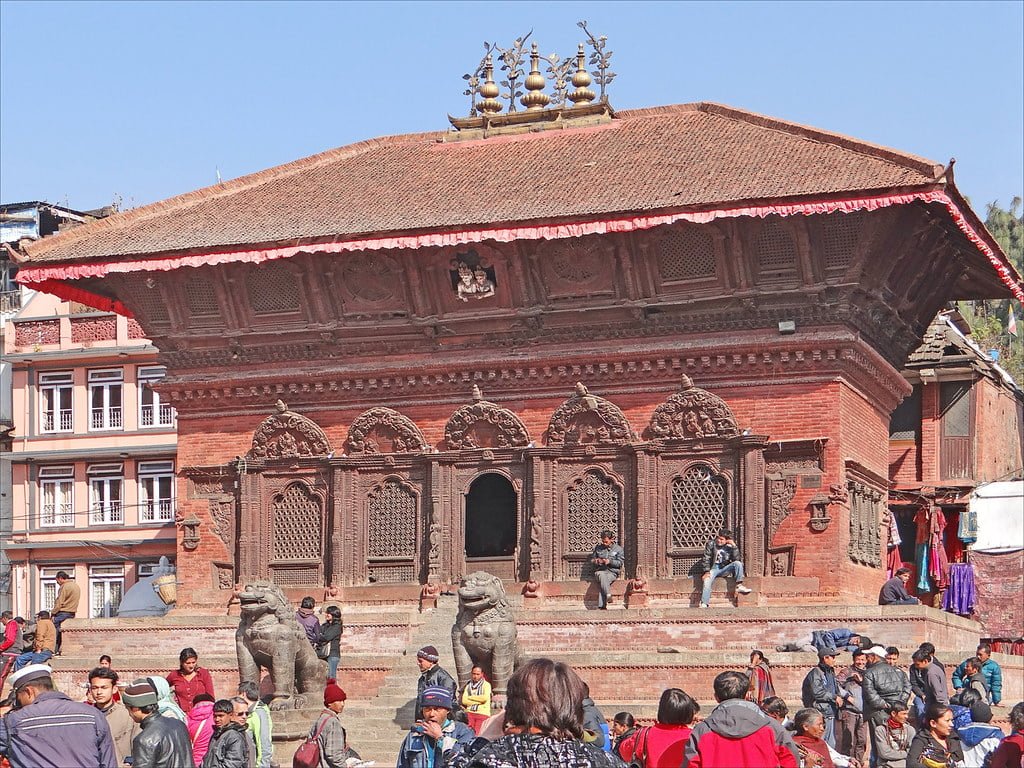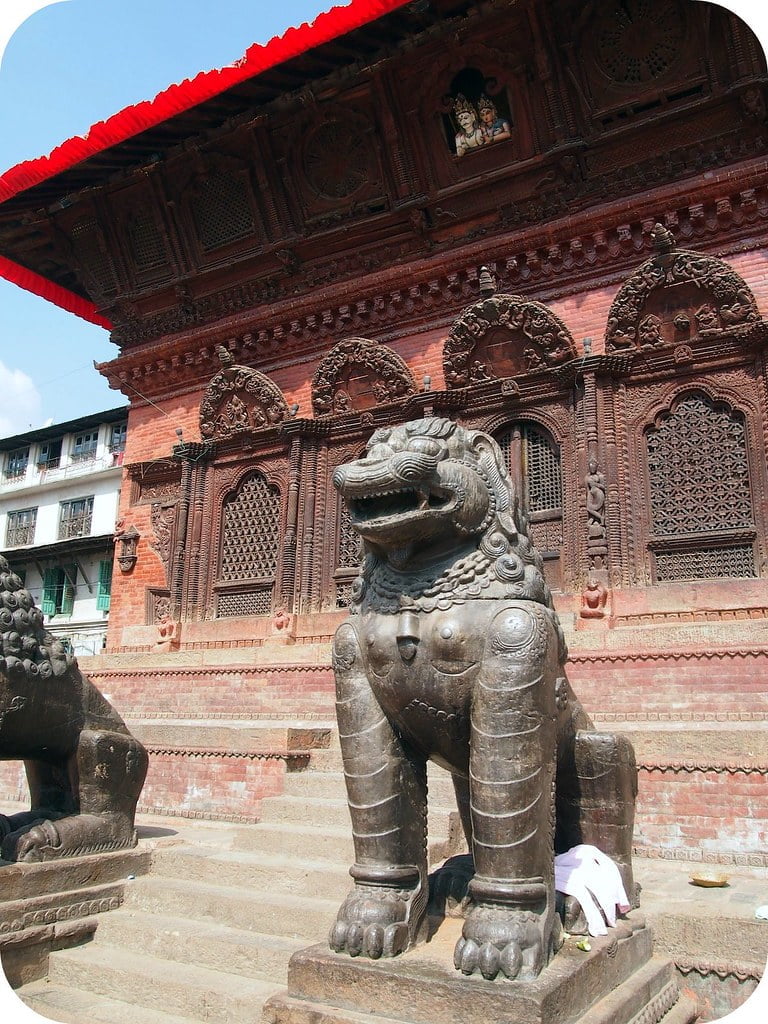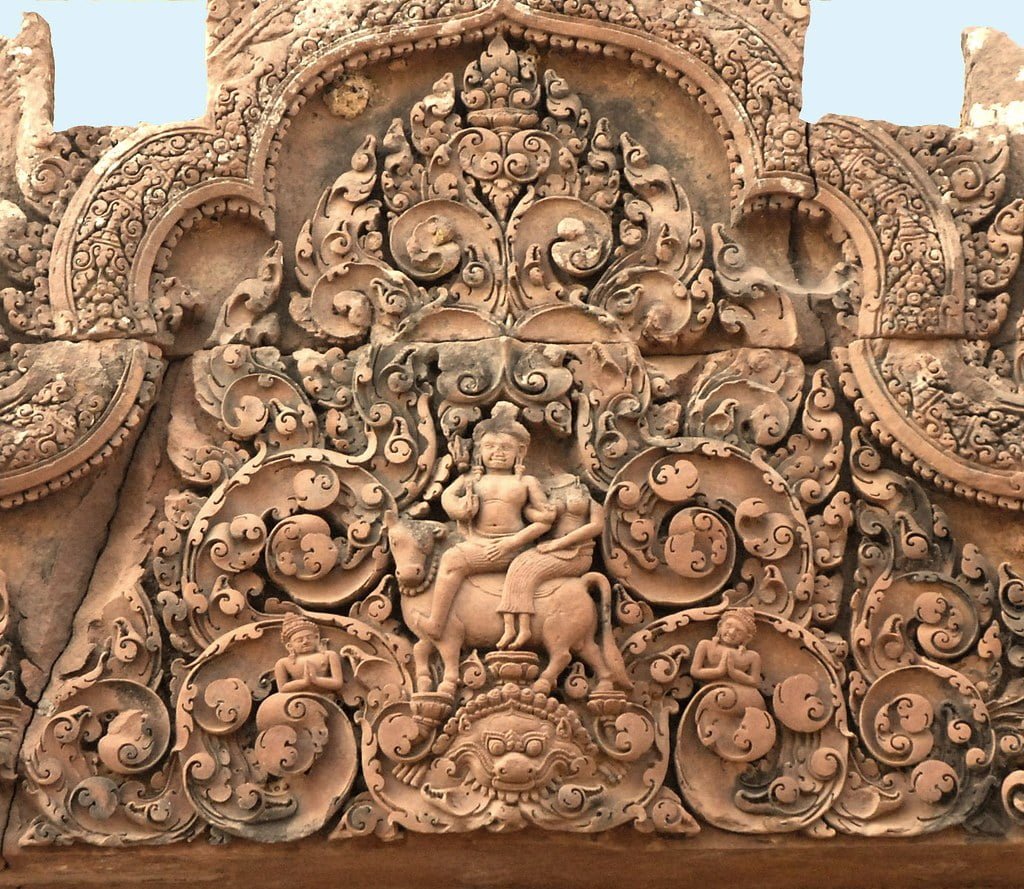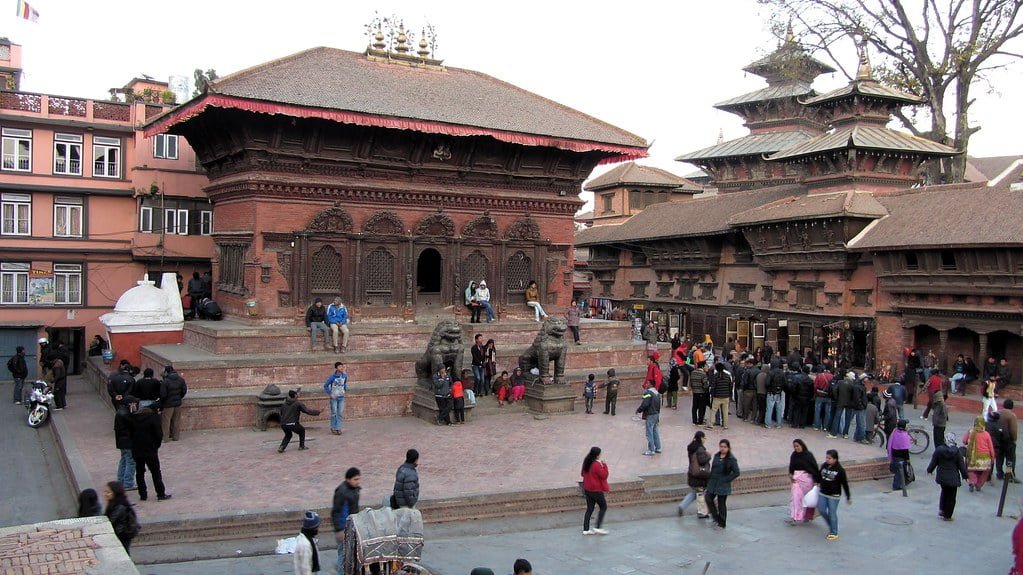Shiva Parvati Temple: A Sacred Place of Worship in Kathmandu
The Shiva Parvati Temple, also known as the Shiva-Parvati (Navadurga) Temple, is a revered Hindu temple located in the enchanting city of Kathmandu, Nepal. Situated on the southwest side of the Basantapur Darbar Square, this temple holds great significance for devotees and visitors alike.
This magnificent temple is a rectangular, two-story building that faces south. It stands proudly northeast of the Maju Dega temple, which unfortunately fell victim to the devastating earthquake of 2015 and is currently undergoing reconstruction. One distinguishing feature of the Shiva Parvati Temple is that it is built with only one roof, which is a departure from the architectural style of most temples in Nepal. According to architectural expert Ronald Bernier, this design choice is characteristic of shrines that are intended as votive offerings.
The history of the Shiva Parvati Temple dates back to the late 18th century. Although precise details about its construction are scarce, the temple’s existence stands as a testament to the devotion and craftsmanship of the people of that era. Its construction and location within the Basantapur Darbar Square highlight the cultural significance of the temple within the heart of Kathmandu.
Inside the temple, visitors are greeted by the divine presence of Lord Shiva, the powerful and revered Hindu deity, and his consort Parvati. The temple showcases various depictions and sculptures of these divine beings, offering a glimpse into the rich mythology and religious beliefs of Hinduism. One notable feature is the presence of wooden figures of Shiva and Parvati in the temple’s windows, seemingly watching over the bustling Durbar Square.
The temple’s serene atmosphere and spiritual ambiance provide a sanctuary for devotees and seekers of inner peace. It serves as a place for prayer, meditation, and reflection, allowing visitors to connect with the divine and experience a sense of tranquility amidst the chaos of daily life.
The Shiva Parvati Temple is not only revered by locals but also attracts visitors from around the world who are drawn to its architectural beauty and spiritual significance. Its location within the Basantapur Darbar Square offers a unique opportunity to immerse oneself in the rich history and cultural heritage of Nepal. Surrounded by other historic buildings and temples, the temple stands as a symbol of the city’s religious and architectural grandeur.
Visiting the Shiva Parvati Temple is a journey that takes one on a spiritual and cultural exploration. It is an opportunity to witness and experience the profound devotion and reverence that Hinduism holds for Lord Shiva and his consort Parvati. Whether you are a spiritual seeker or an admirer of ancient architecture, this sacred sanctuary in the heart of Kathmandu is sure to leave a lasting impression on your soul.

Dravidian Temple Architecture
Dravidian temple architecture is a style of temple design that originated in the southern region of India, particularly in the states of Tamil Nadu, Karnataka, and Andhra Pradesh. This architectural style is characterized by its grandeur, intricacy, and spiritual symbolism, making it a hallmark of South Indian cultural heritage.
One of the most distinctive features of Dravidian temple architecture is the towering gopurams, which are monumental entrance towers adorned with ornate carvings of deities, mythical creatures, and intricate geometric patterns. These gopurams, often adorned with vibrant paintings, serve as the gateway to the sacred space within the temple complex, inviting devotees into the realm of divine worship and spiritual contemplation.
In addition to the striking gopurams, Dravidian temples are known for their expansive courtyards, pillared halls, and intricately carved mandapas, or pavilions, which serve as spaces for religious rituals, cultural performances, and community gatherings. The temple structures are often oriented to align with cosmic principles, reflecting the ancient Hindu belief in the harmony between the microcosm of the temple and the macrocosm of the universe.
The inner sanctum of Dravidian temples houses the main deity or deities, enshrined in sacred chambers adorned with finely sculpted pillars and vibrant murals depicting mythological narratives. The intricate carvings on the temple walls and ceilings, featuring celestial beings, divine episodes, and intricate motifs, serve as visual narratives that transport visitors into the realm of devotion and spirituality.
The architectural elements of Dravidian temples are not merely aesthetic but are deeply imbued with symbolic significance. The vimana, or the towering structure above the sanctum, represents the cosmic mountain Meru, the abode of the gods, while the various sculptural depictions on the temple walls convey moral, spiritual, and mythological teachings to the worshippers.

Unique Features and Stone Statues
The Shiva Parvati Temple boasts a myriad of unique features and astounding stone statues that attract visitors from all over the world. One of the most remarkable aspects of the temple is its architectural design, which seamlessly blends traditional Hindu temple elements with intricate stone carvings and sculptures.
The temple’s exterior is adorned with exquisitely crafted stone statues depicting various Hindu deities, mythological creatures, and celestial beings. These statues showcase the extraordinary craftsmanship and artistic expression of the artists who meticulously carved each piece. Visitors are often mesmerized by the lifelike details and emotional depth captured in the stone sculptures, which evoke a sense of reverence and wonder.
Inside the temple, a sense of serenity permeates the air as devotees and visitors encounter an array of stone statues depicting the divine love and cosmic dance of Lord Shiva and Goddess Parvati. The portrayal of their celestial union through intricate stone carvings serves as a testament to the temple’s spiritual significance and cultural heritage.
Furthermore, the temple houses a collection of unique stone statues that narrate captivating mythological tales and showcase the Hindu pantheon in all its grandeur. Each statue conveys a timeless story or imparts profound philosophical teachings, inviting visitors to delve into the rich tapestry of Hindu mythology and spirituality.
The ambiance created by these stone statues is both awe-inspiring and spiritually uplifting, offering a profound experience for those seeking a deeper connection with the divine. The intricate details and symbolic significance of the stone sculptures make them a focal point of devotion and marvel, drawing pilgrims and art enthusiasts alike to behold their magnificence.

Performance Stages and Courtyards
The Shiva Parvati Temple boasts several performance stages and courtyards, providing a vibrant space for cultural events and religious ceremonies. The temple’s design incorporates a central courtyard surrounded by ancillary courtyards, each serving as a platform for various activities and gatherings.
The main performance stage is intricately adorned with traditional motifs and sculptures, creating an enchanting backdrop for music, dance, and theatrical performances. Additionally, the temple features smaller courtyards that offer intimate settings for spiritual discourses, meditative practices, and smaller-scale performances.
These carefully curated spaces enhance the temple’s ambiance, fostering a harmonious environment where devotees and visitors can immerse themselves in artistic expressions and divine contemplation. Throughout the year, these performance stages and courtyards serve as conduits for cultural exchange and communal celebrations, further enriching the spiritual tapestry of the Shiva Parvati Temple.

Significance of Shiva-Parvati’s Divine Marriage
The divine marriage of Lord Shiva and Goddess Parvati holds profound significance in Hindu mythology and spiritual teachings. Their union symbolizes the intertwining of masculine and feminine energies, portraying the complementary forces that sustain the universe.
According to mythology, Goddess Parvati, also known as Shakti, ardently pursued Lord Shiva, seeking to win his heart and become his consort. Her unwavering devotion and austere penance eventually captured Shiva’s attention, leading to their sacred union. This divine marriage is revered as a celestial representation of love, devotion, and the harmonious balance between purusha (the male principle) and prakriti (the female principle).
The union of Shiva and Parvati is celebrated as an embodiment of marital bliss, mutual respect, and spiritual partnership. Their deep bond exemplifies the ideal of divine companionship, inspiring devotees to seek harmony and understanding in their own relationships. Their union also signifies the inseparable connection between the transcendent and the manifest, illustrating the inseparable link between the divine and the mortal realms.
Furthermore, the divine marriage of Shiva and Parvati signifies the power of transformation and regeneration. It is believed that their union gave rise to their son, Lord Ganesha, who is revered as the obstacle remover and the harbinger of auspicious beginnings. This sacred lineage symbolizes the perpetuation of life, renewal, and the cyclical nature of existence, offering profound lessons on the cycles of creation, preservation, and dissolution.
Seeking Blessings at the Temple
Visiting temples holds great significance in Hindu culture, as it provides an opportunity for devotees to seek blessings from the divine and experience spiritual growth. The temples of Bhimashankar, Somnath, and Triyuginarayan are known for their association with Lord Shiva and Parvati, making them popular pilgrimage destinations for devotees seeking divine blessings and a deeper connection with the divine.
Bhimashankar Temple, located in the Sahyadri hills of Maharashtra, is believed to be the place where Lord Shiva manifested himself in the form of a fiery column of light. It is said that visiting this temple during the auspicious month of Sawan can help devotees overcome obstacles, find inner strength, and experience divine bliss. The temple radiates immense power and energy, and devotees flock to Bhimashankar to seek blessings and experience the presence of Lord Shiva.
Somnath Temple in Gujarat also holds a significant place in Hindu mythology. It has a rich history, having been destroyed and rebuilt multiple times. Devotees visit this temple to seek blessings, witness its historical significance, and feel the eternal presence of Lord Shiva. The temple stands as a symbol of resilience and devotion, and visiting it provides a sense of spiritual connection and inner peace.
Triyuginarayan Temple in Uttarakhand is famous for being the sacred site where Lord Shiva and Parvati got married. This temple holds immense religious importance, and thousands of devotees visit to seek blessings from Lord Vishnu and experience the divine energy. The temple is located on the Chardham Route, making it easily accessible for those undertaking the Chardham Yatra. The tranquil atmosphere and breathtaking surroundings add to the spiritual experience of seeking blessings at Triyuginarayan Temple.
When visiting these temples, it is important to familiarize oneself with the timings and any specific rituals or customs associated with the temple. The devotees are advised to dress modestly and maintain the sanctity of the place. It is also recommended to check the weather conditions, especially when visiting temples in regions like Uttarakhand, where the weather can be unpredictable.
Seeking blessings at these temples is not just a religious practice but also a way to attain inner peace, spiritual growth, and divine blessings. These temples offer a serene and sacred environment, allowing devotees to connect with the divine and experience a sense of tranquility and bliss. Whether it is overcoming obstacles, finding inner strength, or simply seeking divine grace, these temples provide a spiritual sanctuary for devotees on their journey of faith.
